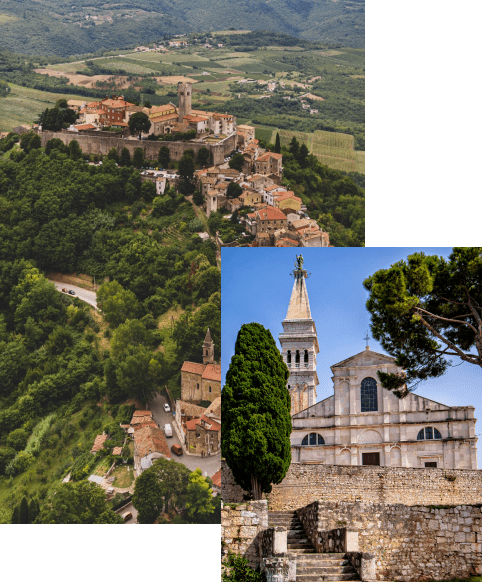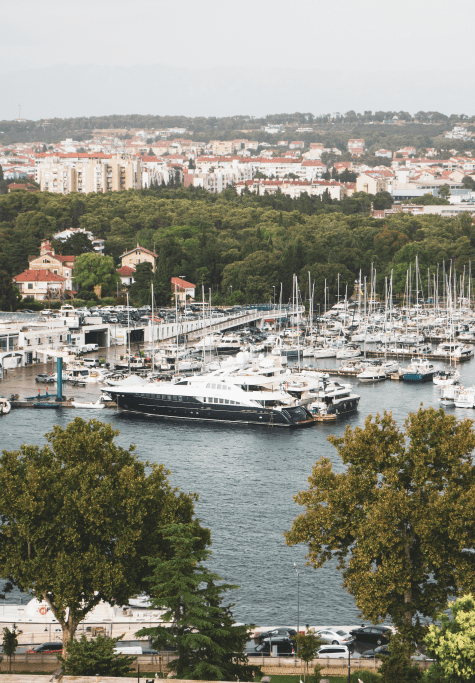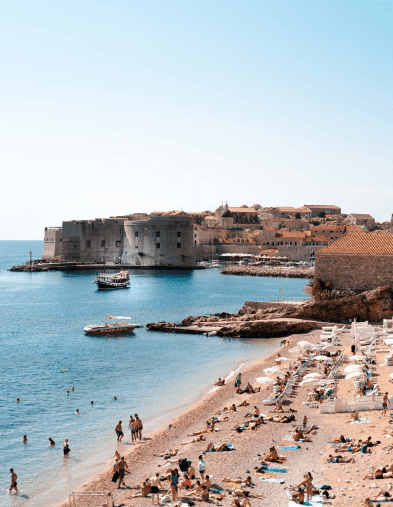Workation » Best Workation Locations and Why You Should Visit Them » Croatia » 5 Regions of Croatia and Where to Visit
The 5 Regions of Croatia and Where to Visit
Croatia’s particular geographical position has made it an important cultural crossroads for millennia, turning the collection of mountains, hills, and coastline making each of the five main regions of the country distinct from one another. Whether on the Istrian greener, set amid the rolling hinterland, or overlooking the Adriatic Sea, each corner of Croatia has been coveted by empires and civilizations since before the arrival of the ancient Greeks in the 4th century BCE.
History informs contemporary life where heritage continues to mix with daily culture. With historic architecture preserved in large cities and small towns, traditional recipes cooked in private kitchens, and scenery protected by national park status, Croatia celebrates its past and encourages a deeper connection to how the customs created the current regional and national culture.
While the historical borders have mainly subsided allowing the regions to melt into the vision of a united Croatia, the regional divisions continue to exude local pride in the form of music, dance, costumes, and of course, the cuisine, often shaped by the local topography. Enjoy the differences and embrace the diversity of Croatia’s five regions during your Workation, as you find the best places to experience authenticity from the islands to the mountain peaks.

Istria
Istria is often considered a magical but also unique region in Croatia, one set apart from the familiar landscapes or expected shorelines throughout the country. The triangular peninsula extends into the Adriatic Sea and into the Gulf of Venice, as well as the Gulf of Kvarner, and is home to a number of the best walkable cities in Croatia.
The peninsula has 267 miles of shoreline resulting in the sea air making as big of an impact on the local culture and heritage as the emerald rolling hills more typical of Tuscany than Croatia. With a collection of thick forests hiding truffles, elegant vineyards terraced across the hills, gorgeous coastlines, and historic cities with foundations dating back to before the Roman Empire, Istria is a microcosmic taste of greater Croatia.

Pula
Pula is the epitome of charm and style in Istria. The preserved Roman amphitheater has become legendary, and locals continue to use it as a stadium to host concerts and cultural events with seating for up to 22,000. Find new ways to travel around Croatia as you visit the town or explore the waterways looking for ancient beauty and architectural marvels.
History aside, the city is a wonderful combination of fragrant pine trees, seaside cafes, and historic homes that overlook the coastline. Explore the streets or use the city as a home base for exploring the wider cape and Brijuni Islands, helping accentuate the best national parks in Croatia.
Rovinj
Rovinj is a vibrant star among bright stars. The streets, the architecture, and the overall atmosphere of Rovinj makes it a wonderful place to visit, even though it lacks a specific monument. It is the type of place where walking the streets, sitting at a cafe, and visiting the shops is all the experience you need or want.
The steep cobblestone streets divide the town like a web leading to small plazas and winding beneath tall church spires. The seaside views look out to the 14 islands of the archipelago, and the colorful tower homes decorate the coastline.
Motovun
Motovun has a quiet wonder. The town crowns an emerald hill that overlooks the Mirna River Valley. Gorgeous in its preservation and enhanced by the continued traditions, when you step into town, it’s like stepping into a fairytale. The forest adds to the storybook quality and wandering along the floor can reveal hidden treasures like the renowned Istrian truffle.
Venetians fortified the town with thick walls in the 14th century and the combination of Romanesque with Gothic architecture frames contemporary art galleries and customary restaurants. The local ingredients and wines cause flavors to practically burst around every corner making Monotvun equal parts discovery, indulgence, and adventure.
Kvarner
The Kvarner region is the link between the mountains and the sea in Croatia. The network of ridges and coastline, vantage points and primeval nature become an unforgettable site specific only to Kvarner. The rugged terrain shelters the gulf protecting its mild climate and glistening cobalt waters.
It was a place of holiday homes for the Austro-Hungarian elite, where palaces continue to watch over the water. Hiking trails, cycling routes, and protected landscapes offer access to unspoiled beauty. Dolphins and turtles swim in the warm waters and griffon-vultures glide through the sky. Remote coves offer fantastic swimming and reflect the rich legacy of seaside escapes, hiking luxuries, and wildlife viewing in Croatia. No matter how you want to experience the country, we have much more information on what to know before your Croatia trip.
Rijeka
A combination of Italianate port, Habsburg elegance, and gritty contemporary architecture, Rijeka is a surprising mishmash of discovery and Croatia’s third-largest city. It is most often passed over or passed through with travelers eagerly heading to Dalmatia but those who stay uncover a fascinating culture, great nightlife, and some of the best festivals in Croatia, including the country’s most popular Carnival.
The center of the city shines a lush green with gardens and the port overtakes the waterfront. What it lacks in beaches, it makes up for in the fantastic opulent history, fairytale architecture, and fantastic views.

Opatija
Opatija is a true treasure of Croatia. The coastal town swells along the Adriatic coast with 19th-century grandeur associated to the Austro-Hungarian Empire. A town of former nobility and aristocracy, it has retained its elegance as the Croatian Riviera that harmonizes with its surroundings rather than overtaking them.
Public gardens, a coastal promenade that runs for nearly six miles, and pristine shoreline that caters to the comforts of beachgoers, and a chocolate festival that runs during Advent, Opatija is an attractive place to visit no matter the time of year.

Slavonia
The historical region of Slavonia sits between the Sava, Drava, and Danube rivers, and was once part of the Kingdom of Croatia dating back to the 10th century. The fertile soil has made the region an important source of food for the greater nation while also contributing to the relaxed atmosphere shaped by the endless stretch of greenery.
Heritage looms large across the region with a focus on unique architecture, towering churches, magnificent castles, and spas that focus on the natural thermal-mineral waters that have been celebrated in the region for centuries.
Osijek
Osijek is the regional capital and provides a river port on the banks of the Drava. Once a major military base for the Habsburg, teh streets are typical of the refined and opulent design of the Austro-Hungarian Empire. What was once a fortress now hums with the contemporary sounds of bars and restaurants or local daily life of private homes.
Local cuisine exudes immense flavor found in typical spices influenced by the connection to Hungary giving you deep insight into the top dishes to eat in Croatia and where to find them. Upper Town features sensational architectural landmarks and the bridges crisscrossing the river provide an unparalleled panorama of the city surpassed in their fame only by the desserts served citywide.
Dakovo
Dakovo is a surprise hidden in the beauty of the Slavonia region and filled with fantastic things to do during your Workation in Croatia. With one of the largest church squares in Europe, as well as a premier riding hall, Dakovo has emerged as a remarkable place to explore cultural tourism. St. Peter’s Cathedral decorates the skyline and is often referred to as the most significant religious complex between Venice and Istanbul.
The hospitality represents authentic, local tradition enhanced by the excellent flavors of seaonal ingredients and preferred wines. Dakovo is not large but makes an unforgettable and indelible impression on all who visit the peaceful, colorful town.
Central Croatia
Saying Central Croatia is the heart of the nation is more than just geographically correct. Covering areas like Gorski Kotar, Hrvatsko Zagorje, and the capital city of Zagreb, the landscape changes from hilly to mountainous and demonstrates some of the finest scenery across the country perfect for exploring during the best months to Visit Croatia for your Workation.
Regional history springs to life in historic cities, cultural landmarks, and winding rivers. Old towns defined as picturesque can feel standard among centuries-old churches and crumbling fortresses. Central Croatia is a more authentic look at where tradition and daily life converge.

Zagreb
Zagreb is Croatia’s capital city and remains the political, cultural, and energetic heart. Zagreb is a city of passion, where bohemian life emerges from the historic streets and the newer architecture shapes the contemporary artistic aesthetic. Church spires pepper the skyline.
The elegance of the former Habsburg Empire decorates the neo-Baroque and Art-Deco architecture contrasting the bland concrete walls of later years making it a consistent best destination in Croatia to visit during your Workation. Boutique shops demonstrate how they keep their fingers to the pulse of modern fashion. Murals add color to the streets, cafes add vibrancy to the neighborhoods, and interesting museums add a touch of Avant-garde youth that reveal truly unique social perspectives.
Hrvatsko Zagorje
Hidden in the northwestern corner of Central Croatia is Hrvatsko Zagorje, a small cultural area that features medieval castles, strongholds, and churches embodying the sweeping breadth of Croatian heritage. The fundamental beauty revolves around nature and the atmosphere of the area capital, Krapina.
The foundations of the town date back to the 12th century and retain a connection to the surrounding castles, as well as a discovery of over 800 Neanderthal fossils. Small, historical, authentic, and overlooked, Hrvatsko Zagorje is a treasure of Central Croatia waiting to be discovered.

Dalmatia
Dalmatia may be the most famous region in Croatia, known for the popular and legendary cities of Dubrovnik and Split. The region consists of the central coastal strip and Adriatic islands covering approximately 233 miles. Rugged barren mountains add to the scenic beauty and provide plenty of panoramic views across the water.
Inhabitants date back to the Illyrians who settled along the Balkan Peninsula around 1,000 BCE. Under Roman, Venetian, and Austro-Hungarian influence, Dalmatia has absorbed incredible culinary traditions while highlighting local flavors and continues to exude tremendous history while also possessing some of the world’s most famous beaches.
Zadar
Zadar is a cosmopolitan and bohemian city at the edge of the upper Dalmatian coast. The historic Old Town features walking-friendly cobblestone streets, medieval churches, and Roman ruins. The natural beauty has inspired local artists to create sensory installations like the Sea Organ and the Sun Salutation, adding layers to how you can engage with the natural and crafted wonders.
The water is crystal-clear and warm in the summer, the restaurants offer fantastic sea views, and ancient history is at your fingertips offering a fantastic collection of Habsburg opulence and ancient religious relics.
Sibenik
Sibenik is on the central Dalmatian coast and beats with a medieval heart. The white-stone architecture glimmers in the sunlight and bounces off the placed waters of the Adriatic Sea. The labyrinth of cobblestone streets leads to hidden homes and open plazas, surprising views and delicious restaurants.
As the gateway to the Kornati Islands, boats fill the marina and the tower homes create an elegant glimpse of history, as well as a line to the fishing traditions. Its setting along the central coast results in mild winters and warm, enjoyable summers perfect for exploring the sleepy back alleys or venturing off to discover the gorgeous islands.
Split
Split is Croatia’s second-largest city and represents the authentic life of the Dalmatian coast. The streets pulse with activity creating an exuberant atmosphere that blends tradition and modernity with ease. Diocletian’s Palace epitomizes the balance between past and present, where the former Roman emperor’s complex hosts boutique shops and cafes.
Impressive Roman monuments feel as prescient today as they did nearly two millennia ago. Old Walls protect the city from expansion and overdevelopment. The cobblestone streets hum with the eccentricities of youthful locals while exhibiting ancient wear and tear. Bordered by coastal mountains and turquoise waters, Split is a grand example of a city that defies singularity.


Dubrovnik
Venetian design, Hungarian elegance, and Renaissance perspectives are all set on a small peninsula jutting out into the Adriatic Sea defining the opulence of Dubrovnik. Named the “Pearl of the Adriatic,” Old Town glows inside the preserved defensive walls. Orange-tiled rooftops offset the turquoise water and the winding cobblestone streets lead to a haven of artists and galleries.
Enjoy the views from the top of Mt Srd, visit the museums that trace the city’s history, or walk along the walls. Palaces lead to fortifications, and the charming alleyways define the undeniable atmosphere combining the glitz of contemporary glamor with the grit of the conserved past whether for a month-long Dubrovnik Workation package or a week-long trip.
Find the Right Time of Year for Your Workation
Each region in Croatia has its own culture, traditions, and connection to local history. They demonstrate the diversity of the landscape and the customs that have shaped the communities before adding to the larger tapestry of Croatian nationalism. Whether finding an immersive town in the hinterlands or finding a common thread connecting the massive defensive walls of southern Dalmatia, you can uncover the unique personalities that shape the greater national character.
Find the right information you need and want to inform your experience visiting Croatia. The more you know, the easier it is to get your Workation experience started. We can maximize your schedule by ensuring your overall experience focuses on a positive work-life balance through a combination of excursions, a work schedule, and local knowledge to make exploring much more accessible. Take one step closer to planning your Workation or find more information about your personalized experience with our Croatia Workation Packages.

